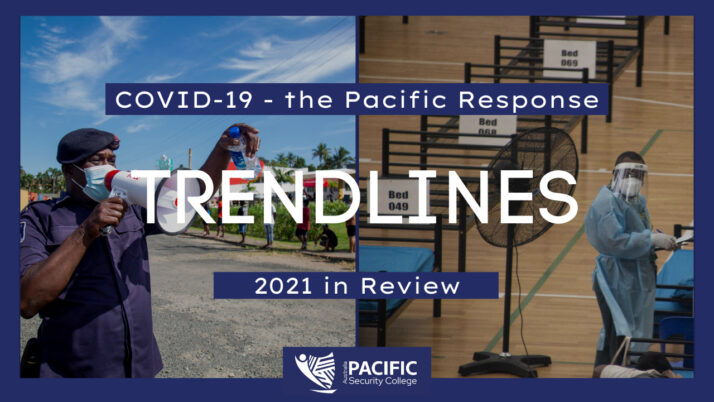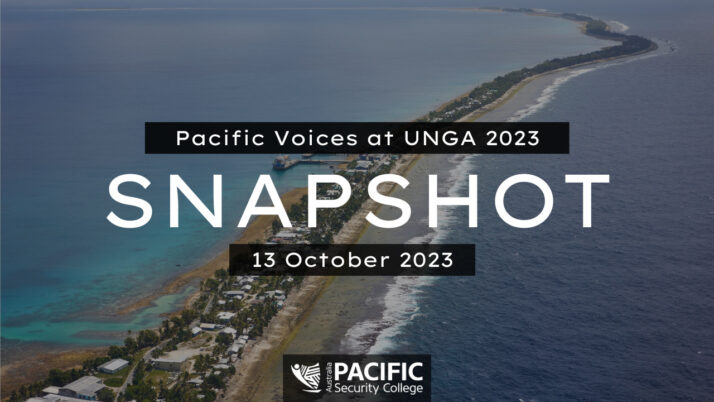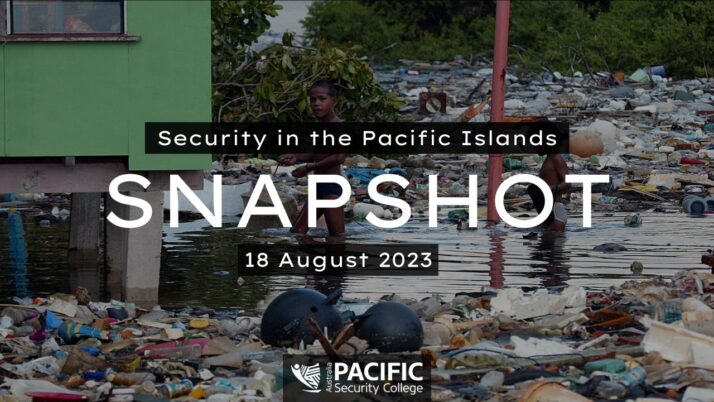COVID-19 – the Pacific response: 2021 in review

Although COVID-19 will remain a major challenge for governments in the Pacific, there is hope that 2022 will see the region reconnecting with the rest of the world.
In 2021, the Pacific’s focus on the COVID-19 pandemic moved from the immediate health challenges of preventing the spread of the virus, to grappling with new variants, vaccination challenges, and re-opening to the world. They have faced significant coordination challenges, as the complexity of government responses have grown. Nations are now judged not just on preventing COVID-19 but balancing economic recovery and access for diaspora populations.
The consequences on the pandemic this year within the Pacific have varied significantly, highlighting the diversity in the region. Many countries in the region, as in 2020, have used their geographical advantages and natural isolation to prevent community transmission of the virus. However, Papua New Guinea (PNG), Fiji, and territories ruled by metropolitan powers, were deeply affected by COVID-19, particularly the Delta variant that swept the world in the middle of this year.
In Micronesia, vaccination rates have varied — from Palau’s world-leading 99 per cent inoculation rate, to countries such as the Federated States of Micronesia and the Marshall Islands, which have struggled to get beyond 30 per cent. Palau, Kiribati and Nauru have remained COVID-free in 2021, while Guam and the Northern Mariana Islands are continuing to see widespread community transmission
Meanwhile in Melanesia, PNG has seen significant suffering due to a devastating Delta outbreak, exacerbated by limited compliance with restrictions and extremely low rates of vaccination. Although peaking in October, large amounts of vaccine hesitancy and a vulnerable health system make the country an easy target for new variants like Omicron.
Fiji also suffered a major Delta outbreak, recording in total over 50,000 cases since the start of the pandemic. However, high vaccination rates saw a controlled border reopening to international tourists in December; a regional first.
Solomon Islands and Vanuatu recorded no cases of community transmission, although a slow vaccination rate is expected to mean that both countries international borders will remain shut in 2022. New Caledonia has since September suffered a deadly Delta outbreak, with over 12,000 cases and 279 deaths recorded. The outbreak defined the French territory’s independence referendum, with many pro-independence groups urging non-participation due to the severity of the COVID-19 crisis.
Finally in Polynesia, Tonga lost its COVID-free status after its first case in quarantine in October. Alongside Samoa, the country is continuing to build its vaccination rates ahead of expected border re-openings in 2022. Tuvalu remained COVID-free alongside Niue, with Cook Islands recording its first case only two weeks ago – albeit in quarantine.
Concerningly, French Polynesia stopped reporting case numbers in August, as its open international border saw numbers explode. The country’s mandatory vaccination laws for those working in healthcare and in other public-facing roles have been a flashpoint for the anti-vaccine movement, and will remain a challenge for its government to manage in 2022.
Beyond its impact on lives, COVID-19 also seriously damaged livelihood’s throughout the Pacific. The Lowy Institute analysis has shown that countries in the Pacific are facing their greatest economic contraction in four decades, as international borders largely remain shut. Countries dependent on tourism for their economic success are still looking at limited prospects in 2022, even as many countries vaccination rates increase.
In 2022, alongside other security challenges like climate change and transnational crime, the region’s policymakers will have to show further resilience and ingenuity as they navigate the region through and out of the pandemic. It will require national, regional, and international cooperation to not only vaccinate the region but also deal with the myriad challenges of a post-pandemic world.
Looking forward, there is hope that the worst of the pandemic is behind the region. Vaccination rates are continuing to increase, countries are starting to re-open, and knowledge of how to live with the virus will only grow. Yet the emergence of variants like Omicron means that the region can take nothing for granted.
Tough times remain ahead, but hope should rise that the Pacific will emerge from the buffering it has suffered during the pandemic
This is the final edition of the Pacific Security College‘s Trendlines series on COVID-19 in the Pacific for 2021. The series will continue monthly in 2022, with the same goal of providing accurate and reliable information to stakeholders in the region. We thank everyone who has engaged with the Trendlines series since April last year, and we look forward to continuing our series in the new year.
More Stories

Security Snapshot - 13 Oct 2023
Pacific Security Snapshot: Pacific voices at the United Nations
In this special edition of the Pacific Security Snapshot, we look at the key issues raised by Pacific leaders at the recent United Nations General Assembly, including climate change, reform to multilateral institutions and ocean health. “These challenges might be inconvenient for large economies – but I can assure the climate impacts already at our…

Security Snapshot - 18 Aug 2023
Pacific Security Snapshot | 18 August 2023
The security stories shaping the region ➣ Pacific Resilience Facility endorsed at the Forum Economic Ministers Meeting ➣ The Pacific Climate Security Assessment Guide ➣ French President Macron visits Papua New Guinea and Vanuatu ➣ US Secretary of State and Secretary of Defence in the Pacific ➣ Bougainville eruption leaves 8,000 displaced Climate Security Ministers…






